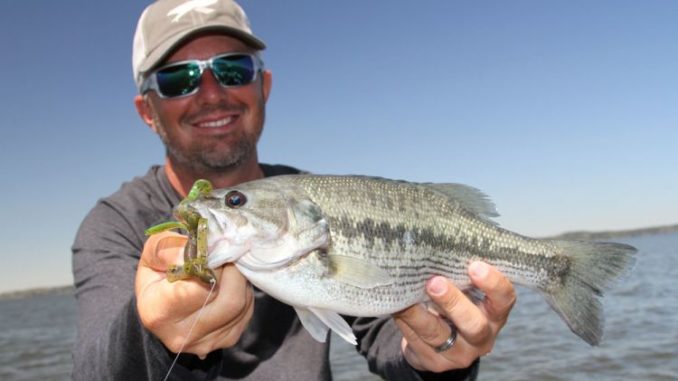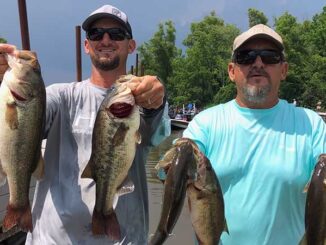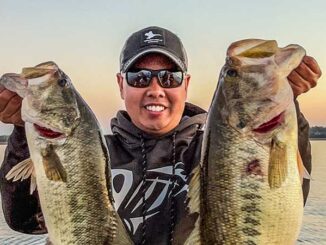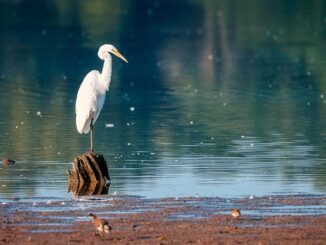
Toledo Bend is famous far and wide for its amazing largemouth bass fishery, but spotted bass call the reservoir home, too. Here’s how you can get in on the fun.
Finding three Bassmaster Elite Series pros working a hot bite less than a rod length from one another is a rarity, if not the prelude to a heated interaction.
But nothing could have been further from the truth when Gerald Swindle, Casey Ashley and Matt Lee lined up along the starboard side of Swindle’s Triton and enjoyed a rod-bending rally with Toledo Bend spotted bass.
SCREEEECH go the brakes. Wait — spotted bass? Aren’t those Toledo Bend giants Florida-strain largemouth?
Yes, the mossback monsters that win tournaments and earn state-sponsored replica mounts are, indeed largemouths. But we’re not talking about big heads, we’re talking about those feisty little boogers with glaring red eyes, prominent spot patterns along their flanks and a distinct connection between the primary (spiny) and secondary (soft) dorsal fins.
No doubt, Toledo Bend’s national renown (#1 on Bassmaster’s Top 100 Best Bass Lakes for 2015 and 2016) comes from its stellar largemouth fishery; however, a lesser-known spotted bass fishery makes this Texas/Louisiana powerhouse somewhat of a geographical oddity — at least in terms of awareness and interest.
More than an afterthought
How big do Toledo’s spots get? Well, the lake record is 3.4 pounds, but Darold Gleason of South Toledo Bend Guide Service says he utters the phrase “Man, that’s a big spot,” for anything over 2. At any size, he points to the species’ accessibility and cooperative nature as a great first impression.
“If you’re trying to get kids into fishing or you’re trying to get a family member interested, spotted bass are great because the techniques you use to catch them are fairly easy to learn and when you get around them, they bite pretty well,” Gleason said. “They’re not really targeted much by tournament fishermen, but for the recreational anglers, they’re really fun.”
True, you’re not going to be calling the IGFA for any of the spots you’ll catch in Toledo Bend; but don’t think these fish are pushovers. Spots pack a load of attitude into those modest bodies, so count on aggressive feeding and spirited fights. Moreover, Swindle said the little hellions fill in nicely when their big green cousins play hard to get.
“I think on Toledo, tournament anglers may not go out there targeting spots, but what you have to realize is that if you’re fishing a multi-day tournament, having a place to fall back and catch a few spots can be the key,” he said.
Where to find ‘em
Ashley, who’s well acquainted with spotted bass thanks to his Lake Hartwell home waters, offers this noteworthy observation: “As a rule of thumb, spots are always a month ahead of largemouth. They spawn deeper, so they spawn earlier and they’ll get on that offshore stuff earlier than largemouth.”
As Gleason points out, summertime often finds spots inhabiting similar areas as largemouth, so you don’t necessarily need to learn a new game. Humps and deep brush can be good options, but day to day, you’ll fare best by targeting main lake points like the one right across from the Cypress Cove launch ramp where Swindle and pals found a pile of spots.
“You’ll also find them on creek channel swings,” Gleason said. “It’s all deep water; I’ve never caught spotted bass shallow.”
Swindle said he’d focus his summer search for Toledo spots on those points and the river channel. Again, nothing alien to largemouth pursuits, except for depth preference.
“The spots will usually be out a little farther,” Swindle said. “If the largemouth are in 20-25, if you look out in 30 you may find you a bunch of spots.”
Also, Ashley said spots are more current-oriented than largemouth. While the latter typically tuck into the slack side of a current break, spots like to sit on the upcurrent side.
What they like
When it comes to summertime spotted bass bait selection, Gleason says you can’t go wrong with a dropshot rig. He likes a V&M Pork Pin worm with a foot-long leader and enough weight for a targeted presentation. He’ll also use a football head jig with a craw trailer and a Carolina-rigged V&M Baby Swamp Hog on a 2-foot leader.
“When you’re catching spotted bass you go through a lot of baits because they’re feisty little things that tear up your baits a lot. That Swamp Hog is a really durable bait, so I tend to get a couple more fish out of every bait.”
Ashley likes a scaled down finesse jig with a Zoom Creepy Crawler twin tail or the Fat Albert twin tail grub. He and Gleason agree that adding chartreuse accents to spotted bass baits can be a real deal closer.
“Spotted bass love chartreuse,” Ashley said. “If they’re in deep water, dying the tips of your jig trailer is a big plus. Also, I like a jig that has a strand or two of chartreuse in it.”
Swindle likes the jig and dropshot, too, but he knows those spots dig a ¼-ounce shaky head. A Zoom Trick Worm in green pumpkin or green pumpkin/blue does the job.
“That time of year, those fish won’t be suspended, they’ll be down there within a foot or two of the bottom,” Swindle said. “That’s why the dropshot and the shaky head work so well; it’s right there on them.”
And don’t forget the shiny stuff, Gleason said: “A jigging spoon is something we use more in the wintertime, but it’s not a bad idea to have one tied on in the summertime; particularly if you have kids or someone who’s new to fishing onboard. It’s an easy bait to work and it’s something that will catch fish.”
One of the most endearing traits of spotted bass is their highly competitive nature. That means firing up a school — maybe with a crankbait or swimbait — can deliver extended rallies that offer everyone aboard multiple opportunities.
“The biggest thing I tell people is to make sure you have more than one (of your favorite bait) tied on,” Gleason said. “That way, if you get into them and you have a tangle or a backlash or you break off, in the time it takes you to sit down and tie a new rig, they can quite biting. It’s beneficial to keep someone fishing for them so you can keep them biting.”


